Best costumes Oscar winner talks about Poor Things and Emma Stone's 'Bella Style'
 Atsushi Nishijima
Atsushi NishijimaOscar-winning designer Holly Waddington explains the hidden meanings behind Emma Stone's 'Bella Style' – from sexual awakening to joyful empowerment.
Finding the right costumes is vital to make a film sing; but rarely are costumes so key to character as they are in Yorgos Lanthimos's film Poor Things, a riff on the Frankenstein story. The work of Holly Waddington, who has just won this year's Oscar for best costume design, they are fundamental to the surreal world in which the film is set, as well as being essential to the characterisation of the protagonist, Bella Baxter, played by Emma Stone – who won the best actress Oscar for the role.
This article contains spoilers for the plot of Poor Things
Rarely in film do characters go through such a gamut of looks. But then, rarely do characters travel from grown woman to toddler to grown woman again all in two hours and 21 minutes. The costumes match Bella, played with abandon by Emma Stone, step for step, beating a frenetic path from infant to fully grown via babydoll dresses, joyful, frothy ruffles, enormous sleeves and forgotten or discarded trousers, before moving into sensible, protective coats and more serious medical-student monochrome.
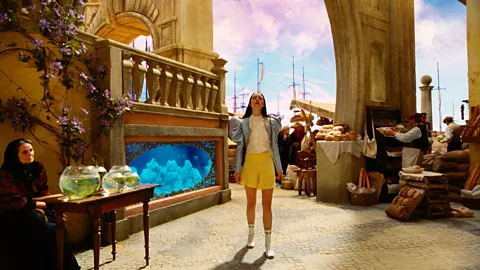 Searchlight Pictures
Searchlight Pictures"Her style is a reflection of where she's at in her development," Waddington tells BBC Culture of what she has called "Bella style", an aesthetic that has also won her a Bafta. "That was what was driving the looks." The result has been called "Age of Innocence meets surrealism meets couture", or Victorian steampunk, and provides a visual narrative through which to understand Bella's character.
Let's start at the end. When Bella, a woman who has arrived back at adulthood, concludes her character arc, she sits contentedly in the freshly unshackled world she has finally been able to craft for herself. It is a darkly utopian scene. She wants to be a doctor and is reading a medical text. Her abusive ex-husband has had the brain of a goat transplanted into his body, and he is grazing and occasionally bleating on the lawn.
She is wearing a knitted cream rollneck and culottes the colour of tobacco. It is an outfit befitting of this brave new world in which she now sits, studying and drinking gin. Grownup and understated, but still with some flair in the sleeve – Bella Baxter, even fully-fledged, is not going to wear an unremarkable sleeve. It could not be further from the outfits that have gone before – gone are the frills of Bella's earlier costumes, gone are the frothy fabrics, gone are the pastels – and speaks volumes about the journey that Bella goes on throughout the film.
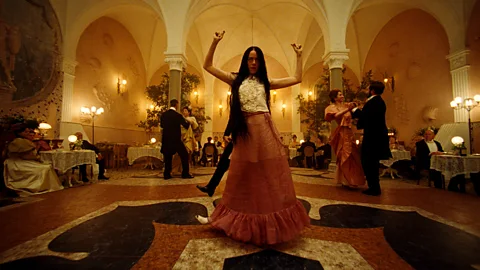 Searchlight Pictures
Searchlight PicturesWhen we first meet Bella, she has been reanimated by Willem Defoe's unhinged scientist Godwin, her adult brain replaced by the brain of her unborn foetus. The costumes fit her new reality: all babyish quilting, ruffles and seersucker, Bella is often barefoot, and wearing just her knickers on her bottom half, top heavy in frothy silhouettes. She is often partially dressed. "If you properly dress a young child for a wedding or a party, they don't stay intact for very long and very quickly they unravel," says Waddington of her thinking. In the early scenes of the film, Bella's character has been dressed by the housemaid, Mrs Prym, but "by mid-morning bits would come off because of the nature of her play".
As Bella's mind grows, her costumes shift. Heading out into the world in the next chapter of the film, and on a trip to Lisbon with the caddish man-baby Duncan Wedderburn, played by Mark Ruffalo, Bella is dressing herself for the first time. The result is devil-may-care and thrilling. A walk around Lisbon, to gorge on pastel de nata and the world at large, sees her wearing a blue jacket and silky, custard-yellow shorts.
More like this:
With no Mrs Prym to dress her, "top bits are left on… and the bottom bit, she's still in the pants but she's forgotten the skirt," says Waddington. "I was trying to catch something of the discordancy that you get when children dress up in a grown-up's clothes." She was inspired by pictures of herself and her sister dressing up as children: "there's this chaos to it, kind of lovely, feels a bit wrong, and I was trying to create something of that."
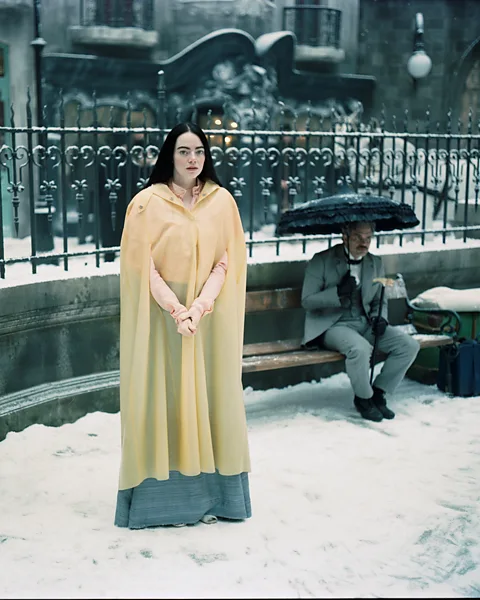 Searchlight Pictures
Searchlight PicturesThat chimes with Deborah Jermyn, a reader in film and television at Roehampton University. "She doesn't have the guidance from inside the oppressive domestic space that she's been in with a housekeeper and this very patriarchal figure, and it gets really playful, eccentric."
Organic and bodily
Her burgeoning, blossoming sexuality is expressed via visceral costumes exploding with pink frothy ruffles, one was given the on-set moniker the "clitoris blouse", another the "vagina blouse". Waddington wanted everything to feel organic and bodily, but not in a "sexy" way, rather inspired by body parts, lungs and organs and intended to give a "sense of the living and the breathing of the body, referencing the textures that are within the human body, so you know the frills of tripe or the sponginess of fat or the smoothness of liver", but also shells, coral and other sea creatures.
As Bella enters the stage of the film set in a brothel, her costumes divert for a moment from visceral and textured to conservatively wrapped up – the so-called "condom coat" seems the perfect outerwear for her arrival at a point where she plans to use her body for exploration and commerce, but not procreation. It is, says Jermyn, "one of those moments where you have to sit up and say 'what's she come out with now, where's this come from?'" Again, she says, "it's partly signalling this movement into another phase…" Bella is now broke, and her attire becomes more functional. "If you think of it as a condom, it's definitely functional," she says.
 Alamy
AlamyFrom there she starts heading to lectures, learning about socialism and, with her newfound academic bent, "she moves into these very dark tones, formal black and a white shirt… more masculine". But, says Jermyn, "obviously she doesn't completely capitulate because she goes out wearing it without a skirt, so she's still doing it her way."
Towards the end of the film, when Bella returns home and plans to marry Max – a hapless medical student who is kind to her but also flawed, as with all the men in the film – the dress she chooses to wed in has sleeves that are grand but delicate and translucent. You can see the cage-like structure within, but they look more like the texture of a mayfly wing than a prison. "All of these men are trying in some way to entrap her," says Waddington, who has always personally "been a bit resistant to marriage… a bit sort of horrified at the idea of being given away on an aisle".
On the red carpet Stone has been dressing in big sleeves at awards season in perfect examples of meta dressing, while from the catwalk to the social media, fashion has been serving up sleeves that announce themselves loudly and take up space literally, refusing to fit neatly under a cardigan. At the Fashion Institute of Technology, the first exhibition of the year was titled Statement Sleeves, and explored how they can be "signifiers of status, taste and personality". But rarely has the spectacle of puffed-up sleeves been given such dramatic depth as when worn by Bella Baxter. A symbol of her refusal to fit in, the protagonist's sleeves can be read as statements of defiance, even as the male characters of the film attempt to disempower her.
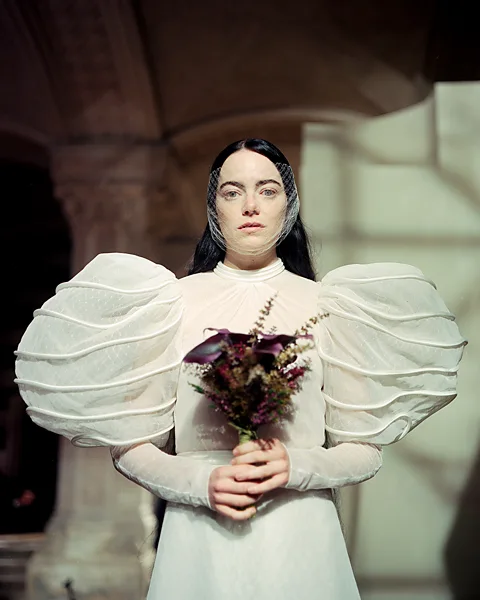 Searchlight Pictures
Searchlight Pictures"Absolutely the big sleeves are about empowerment," says Waddington. Gargantuan and declarative, she got a pattern book from a women's magazine from the 1890s at London's Portobello market and remade them, surprised, perhaps having been conditioned by the demure versions in costume dramas, at just how big they would have been. They took up, she says, a lot of space, but weren't heavy. "It was important to me that the shoulders were air-filled and that they were not heavy and weighty. I wanted them to have a real deftness and lightness to them, to almost feel as though they were full of helium. There's a joyfulness to Bella, you know, there's a lightness to her in the way that she sees the world, and that's important."
Jermyn found the clothes in general "expressive of a certain kind of refusal to conform". Because, "when women wear clothes that aren't necessarily feminising or playing neatly to male fantasies, they're disruptive".
But there is a wider point here: the fact of non-conformist clothes on a body that conforms with traditional standards of beauty – Stone is white, relatively tall and thin. "One of the words that comes up to describe Bella a lot is unruly," says Jermyn. "But her body's not unruly… it conforms to standardised ideas of female beauty. If it was a large body, a black body, another kind of body that you don't generally see promoted in the same way, it would have many different other meanings."
You could question whether Bella is an embodiment of white feminism. Look to the scene where she visits Alexandria, dressed all in white. As writer Jason Okundaye recently noted in the Guardian: "While Lisbon is depicted for its beauty, Alexandria is presented as a cesspit of poverty, a conduit through which Bella can muse on the 'poor things' of Egypt and make vain attempts to improve their lives". The film doesn't necessarily have the same empowering register around non-white communities or people.
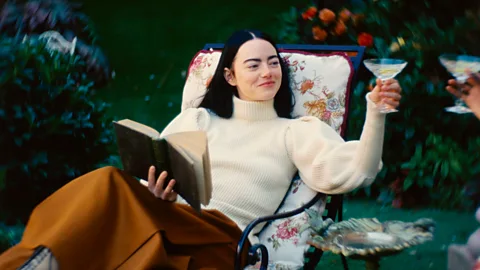 Searchlight Pictures
Searchlight PicturesFor all of Bella's refusal to succumb to the patriarchy, in the many guises it throws at her – from well-intentioned to sordid, scientific and downright silly, much cultural bandwidth has been occupied with how far the film is a product of the male gaze, largely owing to the trio of men at its helm, from screenwriter Tony McNamara to director Lanthimos and the late Alasdair Gray, upon whose 1992 novel of the same name it is based. For Waddington, that reading feels reductive: "I think they made a film with a woman at its absolute centre, that's absolutely ridiculing the patriarchy and the men that surround her."
Wherever you stand on that debate, Waddington had control over the costumes – one of the joys of working with Lanthimos, she says, is that he isn't prescriptive. As Jermyn puts it: "Even if you're troubled by the kind of film having feminist credentials, it's possible to read the clothes as making some kind of feminist statement around the character."
If you liked this story, sign up for The Essential List newsletter – a handpicked selection of features, videos and can't-miss news delivered to your inbox every Friday.
If you would like to comment on this story or anything else you have seen on BBC Culture, head over to our Facebook page or message us on Twitter.
